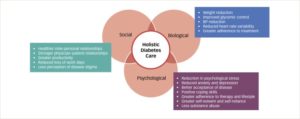Improve the Physical and Mental Health of Older Patients with Hypertension and Type 2 Diabetes with Meditation
By John M. de Castro, Ph.D.
“Though diabetes is a heterogenous disorder, with multiple clinical manifestations, its chronic complications occur due to vascular (endothelial) dysfunction. Mindfulness Meditation helps by improving the autonomic and endocrine regulation of vascular tone, thus leading to better cardiovascular health.” – Sanjay Kalra
Diabetes is a major health issue. It is estimated that 30 million people in the United States and nearly 600 million people worldwide have diabetes and the numbers are growing. Type II Diabetes is heavily associated with other diseases such as cardiovascular disease, heart attacks, hypertension, stroke, blindness, kidney disease, and circulatory problems leading to amputations. As a result, diabetes doubles the risk of death of any cause compared to individuals of the same age without diabetes.
High Blood Pressure (Hypertension) is also a very common disorder with about 70 million American adults (29%) having high blood pressure and only about half (52%) of people with high blood pressure have their condition under control. It is an insidious disease because there are no overt symptoms. The individual feels fine. But it can be deadly as more than 360,000 American deaths per year have high blood pressure as a primary or contributing cause. In addition, hypertension markedly increases the risk heart attack, stroke, heart failure, and kidney disease.
Type 2 diabetes and hypertension are common and increasingly prevalent illnesses, especially in older individual. But they are treatable with medications and largely preventable with lifestyle changes. Recently, mindfulness practices have been shown to be helpful in managing diabetes and also in reducing hypertension. This suggests that there is a need for further research on the effects of meditation training for the treatment of hypertension and Type II diabetes.
In today’s Research News article “Brain education-based meditation for patients with hypertension and/or type 2 diabetes: A pilot randomized controlled trial.” (See summary below or view the full text of the study at: https://www.ncbi.nlm.nih.gov/pmc/articles/PMC6531095/), Lee and colleagues recruited older participants (57-87 years of age) with hypertension and/or Type 2 diabetes and were under medication. The participants were randomly assigned to receive either health education or meditation training twice a week for 8 weeks. Before and after training blood was drawn for biochemical, RNA, and c-DNA analysis and completed questionnaires on their mental and physical health.
They found that in comparison to baseline and health education control group, after meditation training there were significant reductions in blood low-density lipoprotein (LDL), inflammatory gene expression, and levels of fatigue, and significant increases in mental health, including significant increases in relaxation, focus, happiness, and confidence, and significant decreases in anger and loneliness. These results suggest that meditation training is effective in treating older patients with hypertension and/or Type 2 diabetes who are already being treated with medication. Hence meditation practice supplements the benefits of medications.
The reductions in LDL cholesterol have been previously reported with mindfulness training and are very important as LDL cholesterol is a significant marker for cardiovascular disease. The reduction in inflammatory gene expression has also been previously reported and is very important as inflammation is a marker for a variety of disease conditions. In addition, the improvements in mental health have been previously reported and are significant as the elderly have higher levels of mental health difficulties than younger people.
It appears from these results that meditation training as a supplement to medication can be very beneficial for the mental and physical health of older patients suffering from hypertension and/or Type 2 diabetes. It would appear reasonable to recommend meditation training for these patients in addition to their medications.
So, improve the physical and mental health of older patients with hypertension and type 2 diabetes with meditation.
“Recent research showed meditation can also help people with diabetes control their blood sugar levels, lower blood pressure and reduce the risk of cardiovascular disease.” – Roberta Kleinman
CMCS – Center for Mindfulness and Contemplative Studies
This and other Contemplative Studies posts are also available on Google+ https://plus.google.com/106784388191201299496/posts and on Twitter @MindfulResearch
Study Summary
Lee, S. H., Hwang, S. M., Kang, D. H., & Yang, H. J. (). Brain education-based meditation for patients with hypertension and/or type 2 diabetes: A pilot randomized controlled trial. Medicine, 98(19), e15574. doi:10.1097/MD.0000000000015574
Abstract
Background:
Hypertension and type 2 diabetes are chronic diseases, which generally require lifetime care. Meditation and yoga can be complementary to pharmacological therapies according to the scientific evidences so far. Brain education-based meditation (BEM) is a technique, which has been known to change brain structure, psychology, and physiology of healthy adult participants. This randomized, nonblinded pilot trial aimed to examine whether BEM affects the conditions of patients with hypertension and/or type 2 diabetes compared with health education classes.
Methods:
We randomly allocated 48 patients with hypertension and/or type 2 diabetes to BEM (n = 24) or health education (n = 24) classes in the Ulsan Junggu Public Health Center in Korea, where the classes were run during the same period and explored the impact of 8-week practice on the serum glutamic-oxaloacetic transaminase, serum glutamic pyruvic transaminase, gamma glutamyl transpeptidase, creatinine, high-density lipoprotein cholesterol, and low-density lipoprotein (LDL) cholesterol. Total RNA was extracted to examine inflammatory gene expressions from the whole blood using PAXgene blood RNA System. In addition, self-reports on mental/physical health were evaluated. The Student’s t test, chi-squared test, and analysis of covariance were used for statistical analysis.
Results:
The number of people who participated until the completion of the study was 14 in the control and 21 in the BEM group. After 8 weeks, LDL cholesterol level was significantly decreased in the BEM group after the intervention (13.82 mg/dL reduction, P < .05), while it was not significantly altered in the control group. The expression of inflammatory genes was significantly reduced after 8 weeks of the BEM training (0.3-, 0.5-, and 0.2-fold change for NFKB2, RELA, and IL1B, respectively, all P < .05). In the item analysis of mental/physical health self-reports, a significant improvement was confirmed as follows: increases in focus, confidence, relaxation, and happiness; decreases in fatigue, anger, and loneliness (all P < .05). There were no important adverse events or side-effects by BEM intervention.
Conclusion:
Compared to health education, BEM helps lower LDL cholesterol level and the inflammatory gene expression in the patients with hypertension and/or type 2 diabetes. Moreover, BEM induces positive effects on the self-reported mental/physical states, warranting further study.
https://www.ncbi.nlm.nih.gov/pmc/articles/PMC6531095/









